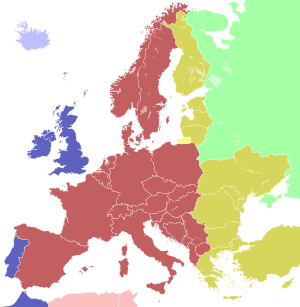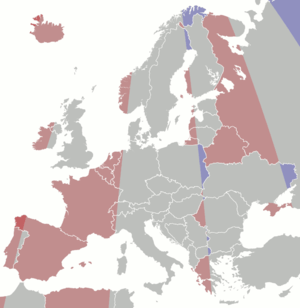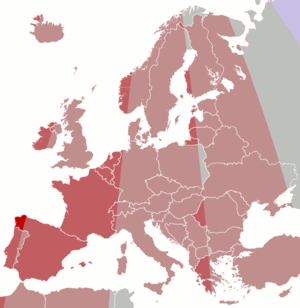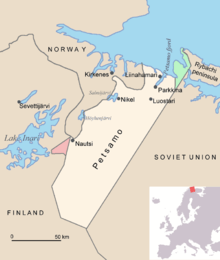Central European Time

| light blue | Western European Time (UTC+0) |
| blue | Western European Time (UTC+0) Western European Summer Time (UTC+01:00) |
| pink | Central European Time (UTC+01:00) |
| red | Central European Time (UTC+01:00) Central European Summer Time (UTC+02:00) |
| yellow | Kaliningrad Time (UTC+02:00) |
| golden | Eastern European Time (UTC+02:00) Eastern European Summer Time (UTC+03:00) |
| light green | Minsk Time, Moscow Time (UTC+03:00) |
Central European Time (CET), used in most parts of the European Union, is a standard time which is 1 hour ahead of Coordinated Universal Time (UTC). The time offset from UTC can be written as +01:00. The same standard time, UTC+01:00, is also known as Middle European Time (MET, German: MEZ) and under other names like Berlin Time, Romance Standard Time, Paris Time or Rome Time.[1]
The 15th meridian east is the central axis for UTC+01:00 in the world system of time zones.
As of 2011 all member states of the European Union observe summer time; those that use CET during the winter use Central European Summer Time (CEST), UTC+02:00, daylight saving time in summer.
Usage
Usage in Europe
- 1890
- 1891
- The areas of current Czech Republic start using CET.
- 1893
- The German Empire unified its time zones to use CET (MEZ).
- Italy, Malta use CET.
- The areas of current Austria start using CET.
- 1894
- Switzerland switches from UTC+00:30 to CET
- Liechtenstein introduces CET.
- Denmark adopts CET.
- 1895
- Norway adopts CET.
- 1900
- Sweden adopts CET.
- 1904
- Luxembourg introduces CET, but leaves 1918.
- 1914
- Albania.
- 1914-1918
- During World War I CET was implemented in all German occupied territories.
- 1920
- Lithuania adopts CET, but rescinds in 1940.
- 1922
- Poland adopts CET.
- 1940
After WWII Monaco, Spain, Andorra and Gibraltar implemented CET.
Portugal used CET in the years 1966–1976 and 1992–1996.
United Kingdom
The time around the world is based on Universal Coordinated Time (UTC) which is roughly synonymous with Greenwich Mean Time (GMT). From late March to late October, clocks in the United Kingdom are put forward by one hour for British Summer Time (BST). Since 1997, most of the European Union aligned with the British standards for BST. Central European Time is thus always one hour ahead of British time.
In 1968 there was a three-year experiment called British Standard Time, when the UK and Ireland experimentally employed British Summer Time (GMT+1) all year round; clocks were put forward in March 1968 and not put back until October 1971.
Other countries
For other countries see UTC+01:00.
Discrepancies between official CET and geographical CET
| Colour | Legal time vs local mean time |
|---|---|
| 1 h ± 30 m behind | |
| 0 h ± 30 m | |
| 1 h ± 30 m ahead | |
| 2 h ± 30 m ahead | |
| 3 h ± 30 m ahead |


Legal, political and economic, as well as physical or geographical criteria are used in the drawing of time zones so official time zones rarely adhere to meridian lines. The CET time zone, were it drawn by purely geographical terms, would consist of exactly the area between meridians 7°30′ E and 22°30′ E. As a result, there are European locales that despite lying in an area with a "physical" UTC+1 time, actually use another time zone (UTC+2 in particular – there are no "physical" UTC+1 areas that employ UTC). Conversely, there are European areas that have gone for UTC+1, even though their "physical" time zone is UTC (typically), UTC−1 (westernmost Spain), or UTC+2 (e.g. the very easternmost parts of Norway, Sweden, Poland and Serbia). On the other hand, the people in Spain still have all work and meal hours one hour later than France and Germany even if they have the same time zone. Following is a list of such "incongruences":
Historically Gibraltar maintained UTC+1 all year until the opening of the land frontier with Spain in 1982 when it followed its neighbour and introduced CEST.
Areas located within UTC+1 longitudes using other time zones
These areas are located between 7°30′ E and 22°30′ E ("physical" UTC+1)
Areas using UTC+2
- The westernmost part of Greece, including the cities of Patras, Ioannina and the island of Corfu
- The westernmost parts of the Bulgarian provinces of Vidin and Kyustendil
- The westernmost part of Romania, including most of the area of the counties of Caraș-Severin, Timiș (capital Timișoara), Arad, and Bihor, as well as the westernmost tips of the counties of Mehedinți and Satu Mare
- The westernmost tip of Ukraine, near the border with Hungary and Slovakia, at the Ukrainian Transcarpathian Oblast (Zakarpattia Oblast), essentially comprising the city of Uzhhorod and its environs. (Although CET is used as local, non-official time in Transcarpathia).
- Western Lithuania, including the cities of Klaipėda, Tauragė, and Telšiai
- Western Latvia, including the cities of Liepāja and Ventspils
- The westernmost parts of the Estonian islands of Saaremaa and Hiiumaa, including the capital of the Saare County, Kuressaare
- The southwestern coast of Finland, including the city of Turku; also the Åland islands (of Finnish jurisdiction) – the Åland islands are the westernmost locale applying EET in the whole of Europe
- The northwesternmost part of Finland, including Kilpisjärvi and Kaaresuvanto.
- The Russian exclave of Kaliningrad Oblast, excluding however its easternmost slice (the city of Nesterov is east of 22°30′ E, but that of Krasnoznamensk is not)
Areas located outside UTC+1 longitudes using UTC+1 time
These areas are located west of 7°30′ E or east of 22°30′ E (outside "physical" UTC+1)
Areas between 22°30′ W and 7°30′ W ("physical" UTC−1)
- The westernmost part of mainland Spain (Galicia, e.g. the city of A Coruña); Cape Finisterre and nearby points in Galicia, at 9°18′ W, are the westernmost places where CET is applied.
- The Norwegian island of Jan Mayen lies entirely within this area and extends nearly as far west as Cape Finisterre, with its western tip at 9°5′ W and its eastern tip at 7°56′ W.
Areas between 7°30′ W and 7°30′ E ("physical" UTC)
- Andorra
- Belgium
- France, except for the absolutely easternmost part, in Alsace, incl. Strasbourg and parts of Alpes-Maritimes, and except for Corsica
- The very westernmost part of Germany, incl. the cities of Saarbrücken, Düsseldorf, Cologne, Aachen, and Trier
- The absolutely westernmost part of Italy, incl. the cities of Aosta in Aosta Valley and Cuneo in Piedmont
- Luxembourg
- Monaco
- Netherlands
- The westernmost part of Norway, incl. the cities of Bergen and Stavanger
- Mainland Spain, except for the westernmost part (see above), Balearic Islands, and the African cities of Ceuta and Melilla.
- Gibraltar
- The part of Switzerland west of Bern (inclusive), also incl. cities such as Geneva, Lausanne, and Fribourg
Areas between 22°30′ E and 37°30' E ("physical" UTC+2)
- The easternmost part of the Republic of Macedonia, including the city of Strumica
- The easternmost part of Serbia, in the Pirot District, including the city of Pirot, and small easternmost parts of Bor District.
- The easternmost tips of Hungary and Slovakia, bordering to the north and south respectively the Ukrainian Transcarpathian Oblast (Zakarpattia Oblast), a bit to the east of Vásárosnamény, Hungary – Uzhhorod, Ukraine (both at 22°18′ E) line
- The easternmost part of Poland, including the cities of Lublin and Białystok
- The northeast of Sweden, in the Norrbotten province, including the cities of Kalix and Haparanda

- The northeast of Norway, lying north of Finland, roughly coinciding with the county of Finnmark; for instance Vadsø, the capital of Finnmark, has a longitude of 29°49′ E. Actually, the easternmost town in Norway, Vardø, lies at 30°51′ E, which is so far east, so as to be east even of the central meridian of EET (UTC+2), i.e. east of Istanbul and Alexandria. The sun reaches its highest point at 10:56 (when not DST).
The Norwegian–Russian border (incl. the border control at Storskog) is the only place where CET (UTC+1/+2) borders Moscow time (UTC+3), resulting in a two hours time change (or one hour in summer) for the passenger crossing that border. - More so, there exists a "tri-zone" point (where UTC+1, UTC+2, and UTC+3 meet) at the Norway–Finland–Russia tripoint near Muotkavaara. Mental experiment when looking at this map: Go to the westernmost point of the red area (the Jäniskoski-Niskakoski area); this belongs to Russian jurisdiction, hence the time there is UTC+3. Then, take a northeastern (NE) direction (that is an eastwards direction); you will soon be crossing into Finnish territory, thus moving to the UTC+2 time zone. Continuing in that direction, you will eventually reach the Finland–Norway border and enter Norway, thus passing into the UTC+1 time zone. So, moving in a (north)easterly direction, you will be moving from UTC+3 to UTC+2 to UTC+1.
See also
- European Summer Time
- Other countries and territories in UTC+1 time zone